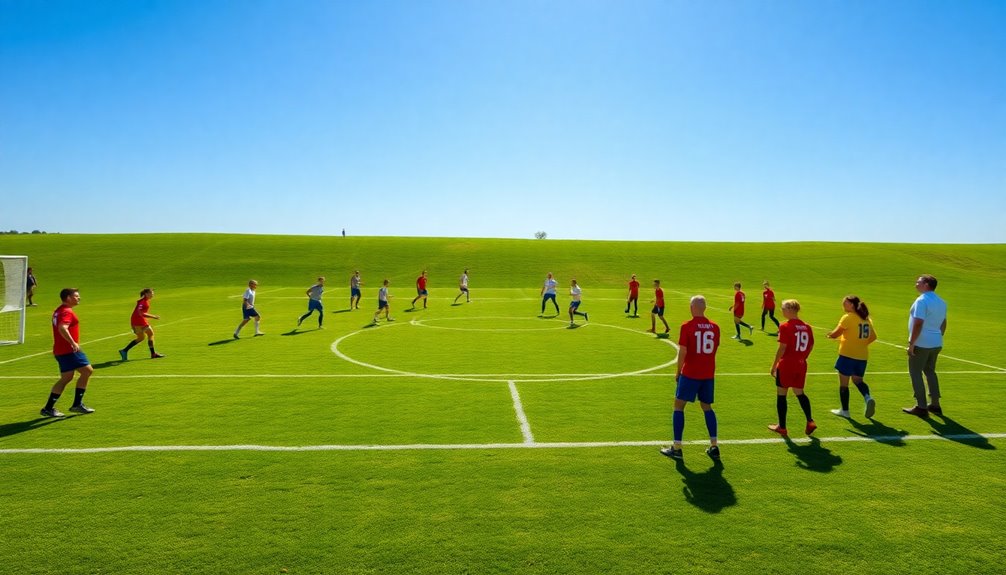
Breaking Down 11v11 Soccer Formations for Tactical Success
March 15, 2025Breaking down 11v11 soccer formations is essential to tactical success. You'll see how formations like 4-4-2 and 4-3-3 influence your team's attack and defense. Each formation has unique strengths, allowing you to adapt based on your players' capabilities. Effective communication and clear roles are vital during gameplay. By mastering these tactical elements, you can enhance team performance and exploit opponents' weaknesses. There's plenty more to discover about how to implement these strategies effectively.
Understanding the Importance of Soccer Formations
Understanding the importance of soccer formations is essential for any coach or player aiming for tactical success. Soccer formations dictate team structure and player roles, shaping how you approach both offense and defense during a match.
As the game evolves, adapting your formation becomes critical; for instance, formations like 4-2-3-1 can create attacking overloads, maximizing your team's offensive potential. However, it's important to align your chosen formation with each player's strengths and weaknesses. Flexibility in formations allows teams to adjust their strategies in response to opponent tactics and game flow. For example, utilizing a defending midfielder can provide additional protection to the defense while facilitating counterattacks.
Different setups come with unique advantages and vulnerabilities, so understanding spacing and positioning can help you exploit opponents' weaknesses effectively. By mastering these principles, you can enhance overall team performance and implement strategies that lead to victory on the pitch. Additionally, effective player selection is crucial for maintaining balance in formations and optimizing team dynamics.
The 4-4-2 Formation: A Classic Approach
The 4-4-2 formation offers a solid balance between defense and attack, making it a popular choice for many teams. You'll appreciate its tactical flexibility, allowing you to adapt your strategy based on the game's flow. Effective communication among defenders can significantly enhance your team's overall performance, as it ensures that players understand their roles and responsibilities on the field. Additionally, understanding defensive formations is essential to ensure solid coverage and role clarity. However, you'll need to guarantee your midfield supports the forwards to maximize your attacking options.
Strengths of 4-4-2
One of the most appealing aspects of the 4-4-2 formation is its balance, making it a classic choice for teams looking to blend defense with attacking potential.
With four defenders and four midfielders, you create two solid banks of four that effectively limit your opponent's space and scoring chances. This structure not only fortifies your defense but also sets the stage for quick counter-attacks.
Your midfielders can support the forwards while utilizing width through wingers, allowing for dangerous crossing opportunities. Teams like Leicester City and Atletico Madrid have successfully harnessed the 4-4-2 in high-stakes matches, proving its effectiveness.
However, remember that maintaining possession and supporting your strikers is essential to maximizing this formation's strengths.
Tactical Flexibility and Adaptation
While many formations have their strengths, the 4-4-2 stands out for its tactical flexibility and adaptability. This formation allows players to adjust their roles based on the game situation, making it a favorite among coaches.
Here are some key aspects:
- Strong defensive structure with two banks of four
- Effective counter-attacking opportunities
- Ability to push outside midfielders wide
- Relies on midfielders' physicality and work rate
- Successful implementations, like Leicester City's title win
With the right players able to execute these strategies, the 4-4-2 can adapt to various opponents.
However, be wary of more dynamic formations; without proper spacing and width, it might struggle to maintain its defensive solidity.
Exploring the 4-3-3 Formation: Attacking Play
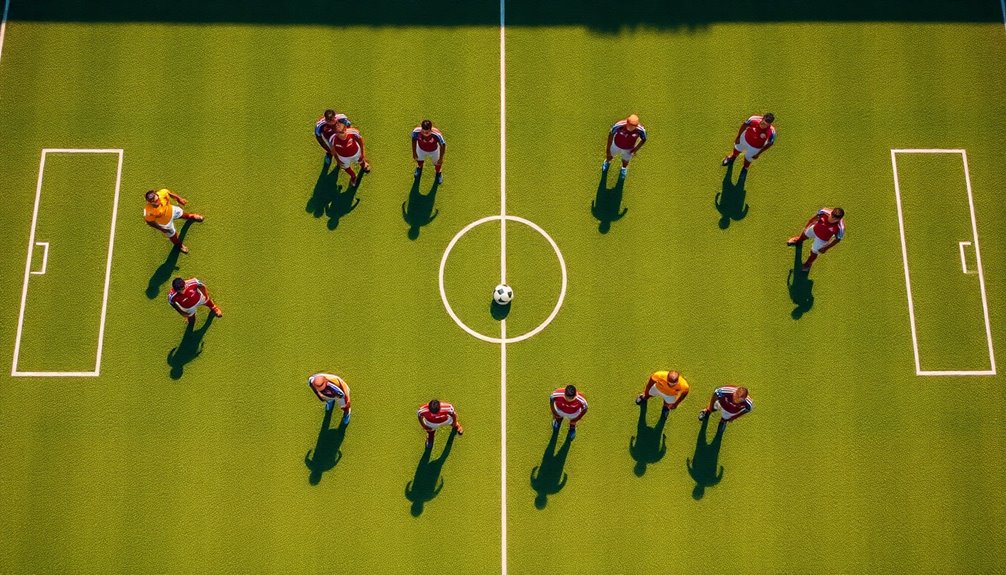
In the dynamic world of soccer, the 4-3-3 formation stands out for its ability to create a potent attacking play. With three forwards, you've got multiple attacking options that can pressure the opponent's defense, which is critical for maintaining possession. This formation can also be complemented by the 2-3-1 formation, which emphasizes teamwork and strategic positioning.
The wingers in this setup stretch the field, opening up space for creative plays and overlapping runs from fullbacks. A strong trio of midfielders is fundamental, as they facilitate quick shifts and ball retention through short passes. The importance of a well-coordinated defensive shape becomes evident when transitioning from attack to defense, ensuring the team remains compact and organized.
The central midfielder often acts as a playmaker, linking defense to offense and orchestrating attacks. However, remember that when fullbacks push forward, it's essential they're supported by defensive midfielders to avoid vulnerabilities at the back. This tactical approach emphasizes defensive stability while encouraging an aggressive offensive strategy.
The 4-2-3-1 Formation: Balance and Flexibility
Building on the attacking prowess of the 4-3-3 formation, the 4-2-3-1 offers a different strategic approach that emphasizes balance and flexibility. This setup features a lone striker supported by three central attacking midfielders, creating a flexible attacking structure that adapts to game dynamics.
Here are some key aspects:
- Strong midfield base with two defensive midfielders
- Easy shifts to 4-3-3 in attack or 4-5-1 in defense
- Central attacking midfielder as the team's playmaker
- Balanced approach for possession and counter-attacking
- Vulnerabilities if wingers fail to track back
Utilizing the 4-2-3-1 allows you to leverage these strengths while managing the inherent risks, making it a versatile formation for any match. Additionally, the role of attacking midfielders is crucial, as they provide creativity and vision to unlock opposing defenses. Effective communication among the midfielders and defenders is essential to maintain defensive coordination and minimize errors. Consistent practice in small-sided games can further enhance the team's adaptability and defensive coordination.
Analyzing the 4-1-4-1 Formation: Midfield Control
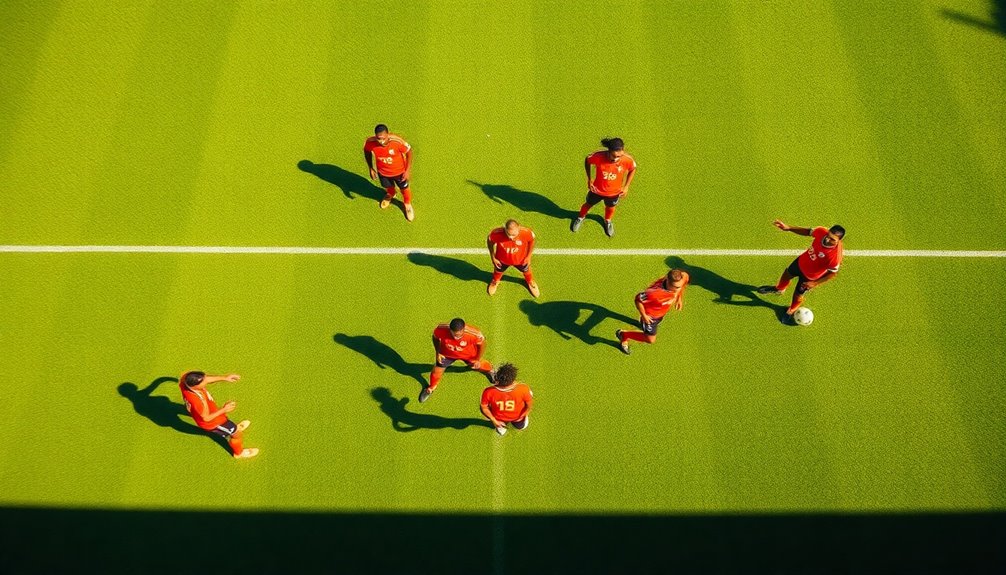
In the 4-1-4-1 formation, you'll find an important balance in midfield structure, where each player's role is essential for both defense and attack.
The defensive midfielder shields your backline while the outside midfielders stretch the opponent's defense, creating opportunities. Agility drills can further enhance the effectiveness of midfield players by improving their quickness and ability to change direction during critical moments. Additionally, mastering defensive stance drills can significantly improve a midfielder's ability to react swiftly to opposing attacks.
As you shift between phases, understanding these dynamics can greatly enhance your team's performance on the pitch. Team captains serve as liaisons with officials, maintaining order and communication during the match.
Midfield Structure and Balance
While the 4-1-4-1 formation primarily emphasizes defensive stability, its midfield structure is fundamental for maintaining balance between offense and defense.
You'll find that effective midfielders in this setup play significant roles:
- A single defensive midfielder shields the back line.
- Four midfielders actively support both defensive duties and shifts.
- The formation can shift to 4-3-3 during attacks for added pressure.
- Midfielders must demonstrate discipline to maintain defensive shape.
- Communication is essential to cover spaces and prevent gaps.
Attacking and Defensive Roles
As you analyze the 4-1-4-1 formation, you'll notice how essential the attacking and defensive roles of the midfielders are for maintaining control of the game.
The single defensive midfielder acts as a shield, breaking up opposition attacks and aiding in changes. Meanwhile, the four central midfielders collaborate to dominate possession, creating passing triangles that enhance fluidity.
The wide midfielders not only support the attack but also track back defensively, striking a balance between offense and defense. This formation excels against teams that focus on central play, leveraging numerical superiority in midfield.
As the lone striker drops back to assist, wingers can push forward, ensuring quick changes and effective counter-attacks.
Transitioning Between Phases
The 4-1-4-1 formation thrives on effective midfield control, allowing teams to quickly shift from defense to attack. By maintaining a solid defensive structure, you can manage changes seamlessly.
Here's how to maximize your effectiveness:
- Utilize the lone defensive midfielder to shield the backline.
- Guarantee disciplined positioning among midfielders to minimize gaps.
- Encourage wingers and the attacking midfielder to interchange for dynamic plays.
- Press from the front with the lone striker to disrupt opponent build-up.
- Communicate effectively to maintain balance during changes.
The 3-4-3 Formation: Creating Overloads
Utilizing the 3-4-3 formation can considerably enhance your team's attacking potential by creating overloads in key areas of the pitch. This setup employs three forwards, stretching opposing defenses and enabling quick combinations and crosses.
Your wing-backs play a pivotal role, providing width and supporting both the attack and defense during shifts. In possession, they help maintain attacking overloads, while out of possession, they can drop back to form a solid 5-4-1.
The central midfielders in the double pivot are essential for linking play and ensuring your wing-backs and forwards receive adequate support.
The Evolution of the 4-4-1-1 Formation

Shifting from the aggressive tactics of the 3-4-3 formation, many teams have embraced the 4-4-1-1 formation to gain better midfield control.
This evolution is marked by:
- Enhanced balance between defense and attack
- An attacking midfielder positioned behind the lone forward
- Strong defensive solidity with two banks of four players
- Quick changes between defense and offense
- Adaptability to shift to a 4-5-1 formation when needed
The 4-4-1-1 provides a robust structure, allowing the attacking midfielder to exploit spaces between the defense and midfield.
Teams like Atletico Madrid and Leicester City have showcased its effectiveness, proving that this formation can secure results against dynamic styles of play while maintaining counter-attacking options.
Insights Into the 3-5-2 Formation
In the 3-5-2 formation, you'll see a unique structure that emphasizes both defense and midfield control.
This setup not only allows for two strikers to create scoring chances but also presents specific strengths and vulnerabilities you need to understand.
Mastering the roles of the wing-backs and maintaining communication among players is key to balancing your team's attacking and defensive efforts.
Formation Structure and Roles
The 3-5-2 formation showcases a balanced structure, featuring three central defenders, five midfielders, and two strikers.
This setup allows you to control the midfield while maintaining flexibility in both attack and defense.
Here's what makes it effective:
- Three central defenders solidify your backline.
- Five midfielders dominate possession and create opportunities.
- Wing-backs provide width in attack and drop back to defend.
- Defined roles for central midfielders enhance tactical execution.
- Two strikers offer direct scoring threats.
Strengths and Vulnerabilities
While the 3-5-2 formation offers a robust structure for both defense and attack, it comes with its own set of strengths and vulnerabilities that coaches must consider.
One of its key strengths is the presence of five midfielders, allowing you to dominate possession and facilitate quick ball movement. This setup enhances attacking options with two strikers upfront.
However, the formation's weaknesses lie in its reliance on wing-backs; if they're caught out of position, you risk exposure to counter-attacks. Additionally, the narrow midfield can struggle against teams that utilize wide formations, making it hard to cover flanks effectively.
To succeed, you need skilled fullbacks and adaptable midfielders, ensuring fluid shifts between defense and attack.
Coaching Strategies for Effective Implementation
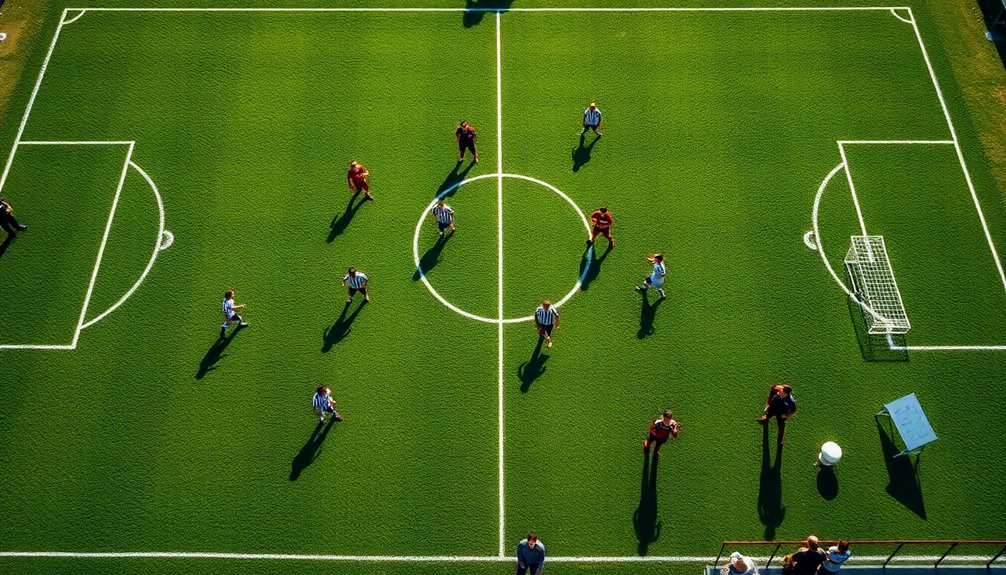
To effectively implement soccer formations, you need to align your coaching strategies with your players' strengths.
Here are some key approaches to contemplate:
- Rotate players through various positions during practice.
- Simplify roles and responsibilities within formations.
- Encourage tactical awareness for quick in-game adjustments.
- Regularly analyze game situations for strategic adjustments.
- Foster communication among players to reduce confusion.
Adapting Tactics Based on Player Strengths
Understanding your players' unique strengths is essential for adapting tactics effectively. Evaluating attributes like speed, technical ability, and tactical intelligence helps you choose the right formations that boost team performance.
For example, if your team has strong wingers, a 4-3-3 formation can exploit their width and enhance attacking play. Conversely, if you possess robust midfielders, a 4-2-3-1 setup may be ideal for controlling possession.
It's crucial to utilize players in their preferred positions; placing strikers as forwards enhances their confidence and goal-scoring chances. Additionally, rotating players through various positions during training can reveal hidden talents, allowing you to adapt tactics that leverage specific skills, like using a defensively skilled midfielder in a more attacking role during matches.
Simplifying Roles for Enhanced Team Performance
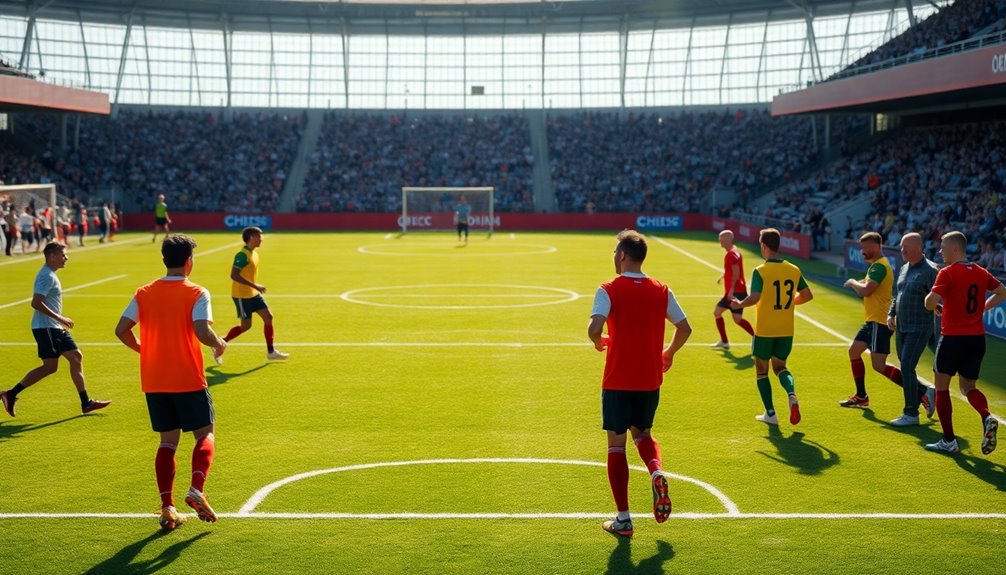
After adapting your tactics to fit your players' strengths, simplifying their roles on the field can greatly enhance team performance.
When you establish clearly defined roles, players will understand their responsibilities better, leading to improved teamwork.
Consider these key points:
- Specialize players in the midfield for tactical depth.
- Utilize strong midfielders to balance attack and defense.
- Rotate positions in practice to develop versatility.
- Foster mastery of specific roles to boost confidence.
- Reduce confusion by maintaining clear expectations.
The Role of Communication in Tactical Success
Effective communication on the field can make the difference between a well-coordinated team and a disjointed one. When you and your teammates prioritize verbal and non-verbal signals, like hand gestures and eye contact, you enhance your formation's effectiveness in both attacking and defending.
Strong communication skills enable you to execute complex formations, such as 4-2-3-1 or 3-4-3, leading to a more cohesive performance. Using clear and concise language helps reduce confusion and speeds up decision-making, allowing you to adapt quickly to opponents' movements.
Regular practice focused on communication fosters a better understanding of tactical roles, strengthening team dynamics. Emphasizing this aspect of the game can elevate your overall performance on the pitch.
Conclusion
In the beautiful game of soccer, formations are your team's blueprint, guiding every play like a conductor leading an orchestra. Whether you favor the classic 4-4-2 or the dynamic 4-3-3, understanding and adapting your tactics can turn a good team into a great one. Remember, it's not just about positioning; it's about harmonizing player strengths and fostering communication. So, lace up those cleats and let your tactical prowess shine, transforming the pitch into your stage for success!


